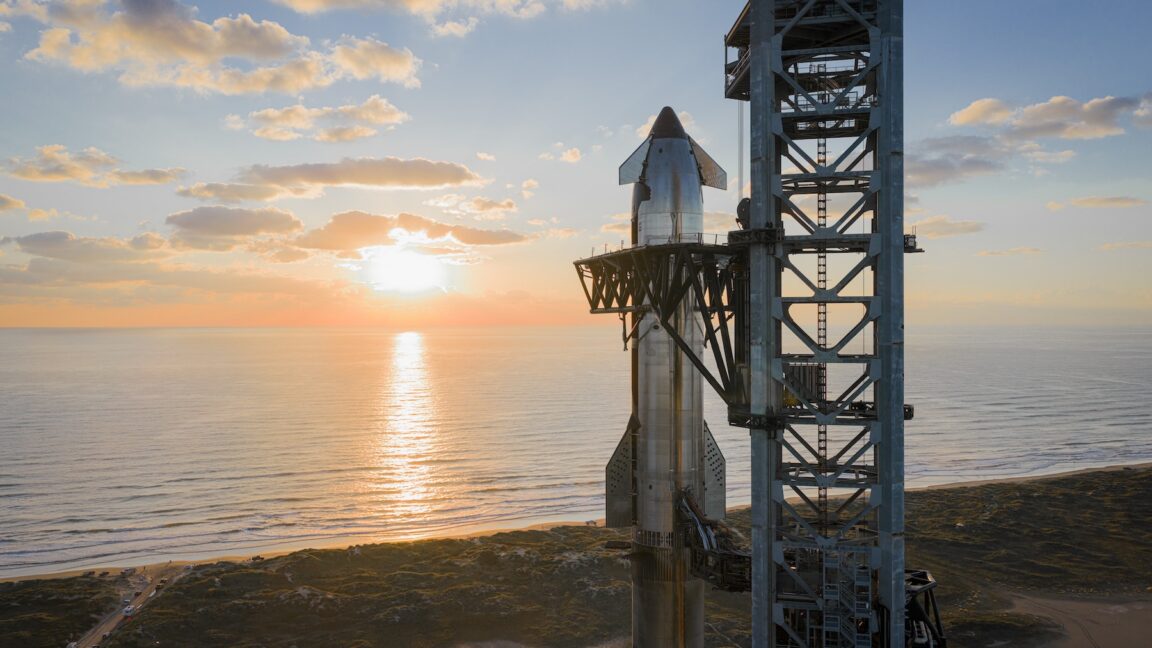Science
SpaceX Launches Starship’s Final Test Flight of 2023

SpaceX successfully launched the eleventh full-scale test flight of its Starship rocket on Monday evening, marking the end of a challenging year for the company. The launch took place from South Texas, with the rocket aiming for a one-hour flight trajectory that concluded in the Indian Ocean. Liftoff occurred at 6:15 PM CDT (7:15 PM EDT; 23:15 UTC), as SpaceX operated within a 75-minute launch window.
The Super Heavy booster, equipped with the Starship upper stage, lifted off with a staggering thrust of approximately 16.7 million pounds. This power is 60 percent more than that of the Soviet N1, the second-largest rocket in history. Notably, this flight utilized a previously flown Super Heavy booster that had successfully launched and landed during a test in March.
Flight Details and Objectives
The test flight followed a trajectory over the Gulf of Mexico, similar to the previous August mission. Two and a half minutes into the flight, the Super Heavy booster was scheduled to separate from the upper stage. As the two stages parted, the six engines on the Starship upper stage ignited to propel the rocket further into space.
SpaceX engineers monitored the flight closely, particularly the new 13-5-3 landing burn engine configuration for the booster. This sequence aims to enhance resilience against engine failures by transitioning from 13 to five engines before relying on three center engines for the final landing phase. The primary objective of this flight was to gather data on real-world vehicle dynamics during engine shutdowns.
Unlike previous missions, the booster targeted a splashdown in the Gulf of Mexico rather than a return to the launch pad for recovery. In orbit, Starship was set to deploy eight Starlink satellite simulators that would follow the same suborbital path and ultimately burn up upon re-entry into the atmosphere.
Testing the Heat Shield
A critical aspect of this mission involved testing Starship’s heat shield, a focus for SpaceX throughout the year. The initial three flights faced challenges with re-entry, but the August flight succeeded in achieving a controlled re-entry and splashdown northwest of Australia. Engineers noted several lessons learned, particularly regarding the replacement of ceramic tiles with metallic insulators.
For this flight, SpaceX removed tiles from specific areas of the Starship to intentionally stress-test vulnerable sections of the vehicle. Some of these tiles were removed from spots where they were directly bonded to the stainless-steel skin without a backup ablative layer. The goal is to identify an optimal tile design that can withstand the extreme conditions during re-entry, where temperatures can soar to 2,600° Fahrenheit (1,430° Celsius).
Future flights are expected to see the Starship returning to the launch site at Starbase, where engineers plan to catch the vehicle using tower arms, similar to the recovery methods employed for the Super Heavy booster. However, this capability is still a few flights away.
As 2023 concludes, this test flight represents the last for the current version of Starship. SpaceX is preparing for the introduction of Version 3, which is anticipated to debut in early 2026. This new iteration will feature upgraded Raptor engines and larger propellant tanks, along with capabilities for in-orbit refueling.
NASA is counting on an increased flight rate from SpaceX to fulfill its contract for a human-rated lander as part of the Artemis lunar program. With contracts valued at over $4 billion, SpaceX is focused on demonstrating reliable and rapid reuse of Starship, crucial for future missions to the Moon and Mars.
In preparation for these ambitious goals, SpaceX is building additional launch infrastructure, including a second launch pad at Starbase and new facilities in Florida. The upcoming test of in-orbit refueling remains a critical challenge as the company moves forward with its plans for deep space exploration.
-

 Education3 months ago
Education3 months agoBrandon University’s Failed $5 Million Project Sparks Oversight Review
-

 Science4 months ago
Science4 months agoMicrosoft Confirms U.S. Law Overrules Canadian Data Sovereignty
-

 Lifestyle3 months ago
Lifestyle3 months agoWinnipeg Celebrates Culinary Creativity During Le Burger Week 2025
-

 Health4 months ago
Health4 months agoMontreal’s Groupe Marcelle Leads Canadian Cosmetic Industry Growth
-

 Technology3 months ago
Technology3 months agoDragon Ball: Sparking! Zero Launching on Switch and Switch 2 This November
-

 Science4 months ago
Science4 months agoTech Innovator Amandipp Singh Transforms Hiring for Disabled
-

 Education3 months ago
Education3 months agoRed River College Launches New Programs to Address Industry Needs
-

 Technology4 months ago
Technology4 months agoGoogle Pixel 10 Pro Fold Specs Unveiled Ahead of Launch
-

 Business3 months ago
Business3 months agoRocket Lab Reports Strong Q2 2025 Revenue Growth and Future Plans
-

 Technology2 months ago
Technology2 months agoDiscord Faces Serious Security Breach Affecting Millions
-

 Education3 months ago
Education3 months agoAlberta Teachers’ Strike: Potential Impacts on Students and Families
-

 Science3 months ago
Science3 months agoChina’s Wukong Spacesuit Sets New Standard for AI in Space
-

 Education3 months ago
Education3 months agoNew SĆIȺNEW̱ SṮEȽIṮḴEȽ Elementary Opens in Langford for 2025/2026 Year
-

 Technology4 months ago
Technology4 months agoWorld of Warcraft Players Buzz Over 19-Quest Bee Challenge
-

 Business4 months ago
Business4 months agoNew Estimates Reveal ChatGPT-5 Energy Use Could Soar
-

 Business3 months ago
Business3 months agoDawson City Residents Rally Around Buy Canadian Movement
-

 Technology2 months ago
Technology2 months agoHuawei MatePad 12X Redefines Tablet Experience for Professionals
-

 Business3 months ago
Business3 months agoBNA Brewing to Open New Bowling Alley in Downtown Penticton
-

 Technology4 months ago
Technology4 months agoFuture Entertainment Launches DDoD with Gameplay Trailer Showcase
-

 Technology4 months ago
Technology4 months agoGlobal Launch of Ragnarok M: Classic Set for September 3, 2025
-

 Technology4 months ago
Technology4 months agoInnovative 140W GaN Travel Adapter Combines Power and Convenience
-

 Science4 months ago
Science4 months agoXi Labs Innovates with New AI Operating System Set for 2025 Launch
-

 Top Stories2 months ago
Top Stories2 months agoBlue Jays Shift José Berríos to Bullpen Ahead of Playoffs
-

 Technology4 months ago
Technology4 months agoNew IDR01 Smart Ring Offers Advanced Sports Tracking for $169










